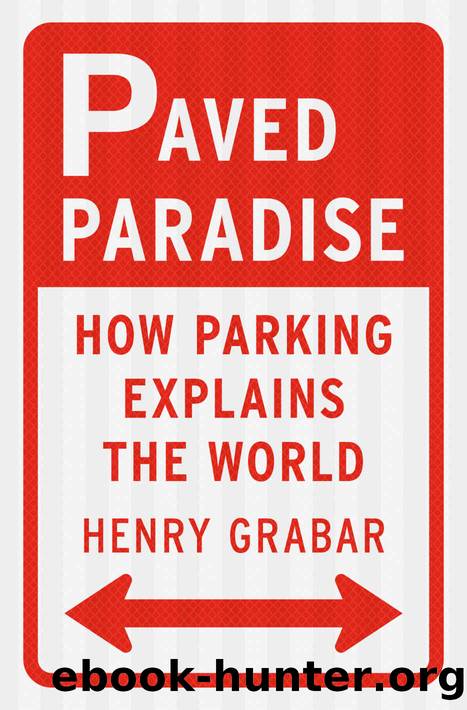Paved Paradise by Henry Grabar

Author:Henry Grabar [Grabar, Henry]
Language: eng
Format: epub
Publisher: Penguin Publishing Group
Published: 2023-05-09T04:00:00+00:00
* * *
To really grasp the impact of parking minimums, you had to see what happened when they disappeared. In 1999, Carol Schatz got Los Angeles to pass an Adaptive Reuse Ordinance (ARO) for downtown. This law was supposed to make it easier to renovate the areaâs aging, vacant buildings. It proposed an alternative seismic code. It granted a by-right exemption from the cityâs difficult permitting process. And it freed builders entirely from the obligation to provide parking when they turned commercial buildings into residential ones. Expectations were low. Just as early parking requirements had been viewed as an incremental solution to downtownâs woes, so too relief from the requirements was seen as a half measure. âWe had to make chicken salad out of you-know-what,â Schatz said.
But just like that, the walls of the Forbidden City came crashing down.
The first builder to bite was an Israeli-born subdivision developer named Izek Shomof. Shomof came to California as a kid and worked for a spell flipping burgers downtown. It was a ghost town after dark. How dead was downtown LA? In 1991, Shomof was able to buy the former Los Angeles Stock Exchange, a twelve-story tower, for $2 million in 2020 dollars. Itâs probably worth twenty times that today. In 2001, Shomofâs Spring Towers Lofts was the first building renovated under the ARO to open. Its three dozen apartments had fifteen-foot ceilings. Shomof carved a garage out of the first floor and the basement, though he was only able to get about twenty-five spacesâdozens short of what the code would have required. Some of the tenants parked downstairs; some parked a block away, and some didnât own cars at all. âWithout the ordinance easing parking, downtown would be as dead as it was in the seventies, eighties, and nineties,â Shomof said.
Then came Barry Shy, a secretive, quarrelsome builder who turned Shomofâs model into a system. Using private equity, Shy was able to buy and renovate faded, vacant commercial buildings faster than anyone else. His apartments were relatively affordable, tooâin part because the price of parking was never folded into the lease. Shy let tenants figure it out themselves. By 2010, a decade after the ARO, Shy was the second-largest residential landlord downtown and had created more than 1,500 new apartments.
But the guy who got the glory was Tom Gilmore. Shomof saw an opportunity; Shy was an operator. Gilmore was a true believer. There he was on the cover of the Los Angeles Times Magazine in October 1999, glowing in the setting sun, standing against the granite facade of the 1905 Farmers and Merchants National Bank. Gilmore bought it for $100,000, one one-hundredth of its original construction cost. Headline: reclaiming the badlands. In the spread, there was Gilmore again, looking like Bruce Wayne, tie dangling over the fire escape railing on the top floor of the Continental Building, with its Corinthian columns, cornucopias of terra-cotta fruits, and cornice of lionsâ heads. For many decades, this was the cityâs tallest office building. Now it was at the center of Gilmoreâs plans to revive downtown: the Old Bank District.
Download
This site does not store any files on its server. We only index and link to content provided by other sites. Please contact the content providers to delete copyright contents if any and email us, we'll remove relevant links or contents immediately.
International Integration of the Brazilian Economy by Elias C. Grivoyannis(74782)
The Radium Girls by Kate Moore(11621)
Turbulence by E. J. Noyes(7700)
Nudge - Improving Decisions about Health, Wealth, and Happiness by Thaler Sunstein(7242)
The Black Swan by Nassim Nicholas Taleb(6764)
Rich Dad Poor Dad by Robert T. Kiyosaki(6175)
Pioneering Portfolio Management by David F. Swensen(6079)
Man-made Catastrophes and Risk Information Concealment by Dmitry Chernov & Didier Sornette(5647)
Zero to One by Peter Thiel(5488)
Secrecy World by Jake Bernstein(4388)
Millionaire: The Philanderer, Gambler, and Duelist Who Invented Modern Finance by Janet Gleeson(4094)
The Age of Surveillance Capitalism by Shoshana Zuboff(3983)
Skin in the Game by Nassim Nicholas Taleb(3965)
The Money Culture by Michael Lewis(3846)
Bullshit Jobs by David Graeber(3830)
Skin in the Game: Hidden Asymmetries in Daily Life by Nassim Nicholas Taleb(3723)
The Dhandho Investor by Mohnish Pabrai(3560)
The Wisdom of Finance by Mihir Desai(3523)
Blockchain Basics by Daniel Drescher(3329)
